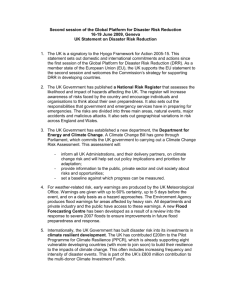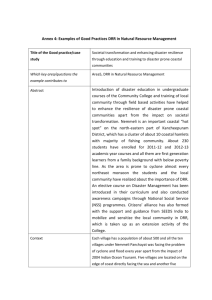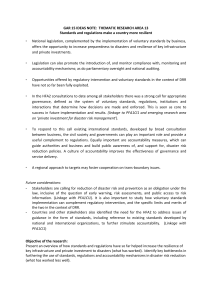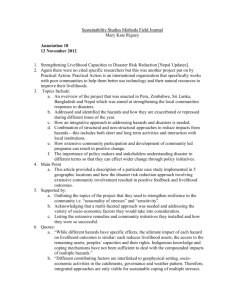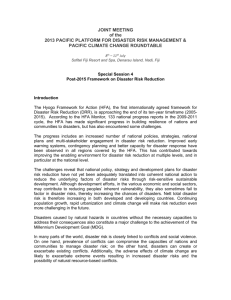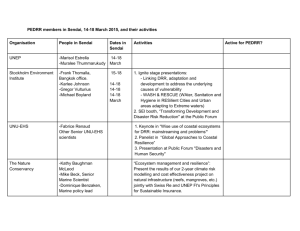PEDRR Key Messages Post-2015 DRR Framework
advertisement
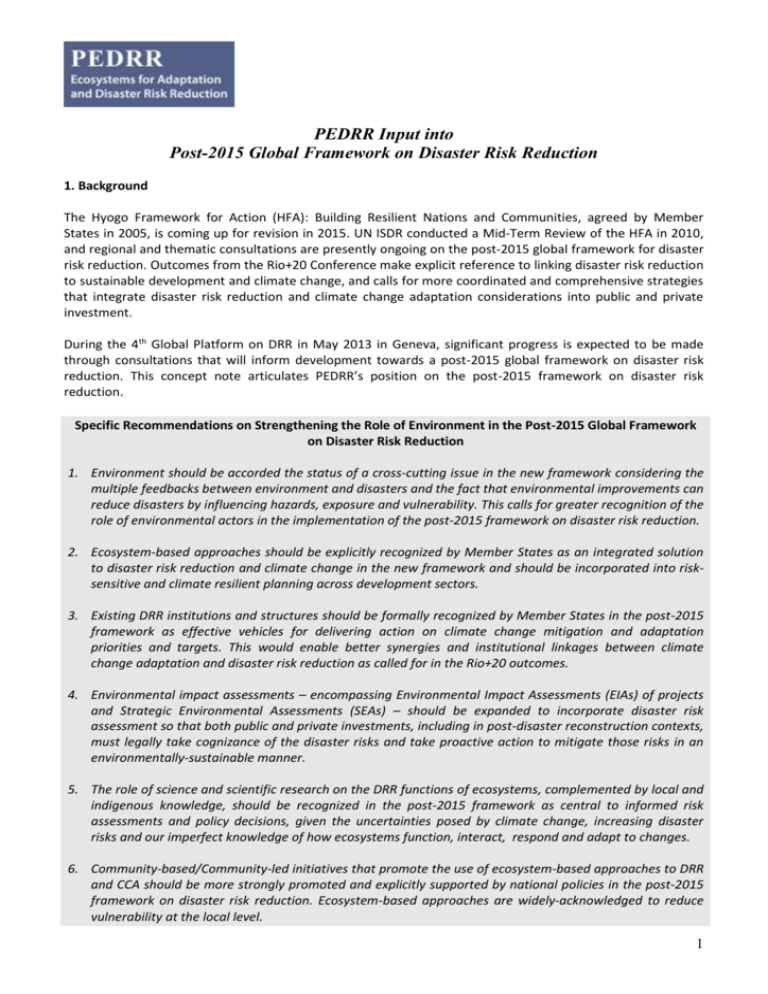
PEDRR Input into Post-2015 Global Framework on Disaster Risk Reduction 1. Background The Hyogo Framework for Action (HFA): Building Resilient Nations and Communities, agreed by Member States in 2005, is coming up for revision in 2015. UN ISDR conducted a Mid-Term Review of the HFA in 2010, and regional and thematic consultations are presently ongoing on the post-2015 global framework for disaster risk reduction. Outcomes from the Rio+20 Conference make explicit reference to linking disaster risk reduction to sustainable development and climate change, and calls for more coordinated and comprehensive strategies that integrate disaster risk reduction and climate change adaptation considerations into public and private investment. During the 4th Global Platform on DRR in May 2013 in Geneva, significant progress is expected to be made through consultations that will inform development towards a post-2015 global framework on disaster risk reduction. This concept note articulates PEDRR’s position on the post-2015 framework on disaster risk reduction. Specific Recommendations on Strengthening the Role of Environment in the Post-2015 Global Framework on Disaster Risk Reduction 1. Environment should be accorded the status of a cross-cutting issue in the new framework considering the multiple feedbacks between environment and disasters and the fact that environmental improvements can reduce disasters by influencing hazards, exposure and vulnerability. This calls for greater recognition of the role of environmental actors in the implementation of the post-2015 framework on disaster risk reduction. 2. Ecosystem-based approaches should be explicitly recognized by Member States as an integrated solution to disaster risk reduction and climate change in the new framework and should be incorporated into risksensitive and climate resilient planning across development sectors. 3. Existing DRR institutions and structures should be formally recognized by Member States in the post-2015 framework as effective vehicles for delivering action on climate change mitigation and adaptation priorities and targets. This would enable better synergies and institutional linkages between climate change adaptation and disaster risk reduction as called for in the Rio+20 outcomes. 4. Environmental impact assessments – encompassing Environmental Impact Assessments (EIAs) of projects and Strategic Environmental Assessments (SEAs) – should be expanded to incorporate disaster risk assessment so that both public and private investments, including in post-disaster reconstruction contexts, must legally take cognizance of the disaster risks and take proactive action to mitigate those risks in an environmentally-sustainable manner. 5. The role of science and scientific research on the DRR functions of ecosystems, complemented by local and indigenous knowledge, should be recognized in the post-2015 framework as central to informed risk assessments and policy decisions, given the uncertainties posed by climate change, increasing disaster risks and our imperfect knowledge of how ecosystems function, interact, respond and adapt to changes. 6. Community-based/Community-led initiatives that promote the use of ecosystem-based approaches to DRR and CCA should be more strongly promoted and explicitly supported by national policies in the post-2015 framework on disaster risk reduction. Ecosystem-based approaches are widely-acknowledged to reduce vulnerability at the local level. 1 2. Understanding Environment and Disaster Risk Reduction Linkages Environment and disasters interact in multiple ways; the most important feedback mechanisms are: 1. 2. Environmental degradation can lead to disasters (e.g. deforestation causing landslides); Environmental degradation aggravates other hazards (e.g. destruction of coral reefs and seagrasses intensifies the impacts of storm surges on coasts); Disasters cause environmental damage (e.g. tsunami destroying coastal habitats, chemical spills impacting rivers; and post-disaster reconstruction can exacerbate water abstraction and deforestation); Environmental degradation linked to disasters impacts people’s livelihoods, which in turn reduce their resilience to all disasters; Ecosystems (wetlands, forests, coastal and marine systems, etc.) have important functions that influence all three dimensions of the disaster risk equation – by preventing, mitigating or regulating hazards (e.g. flooding, avalanches, heat waves), by acting as natural buffers and reducing people’s exposure to hazards, and by reducing vulnerability to hazard impacts through supporting livelihoods and basic needs (food, water, shelter, fuel) before, during and after disasters. 3. 4. 5. In addition, climate change acts as a magnifying factor on all disasters, both climatic and non-climatic. Climate change increases the frequency and intensity of certain hydro-meteorological hazards, especially heat waves, and will likely increase people’s vulnerability to other climatic hazards such as flooding, drought, wildfires, tropical storms and slope instabilities/mass movements, in particular regions. Climate change can also aggravate people’s vulnerability to non-climatic disasters, contributing for instance to population displacements and greater exposure to both climatic and non-climatic hazards. 3. Environment in the Hyogo Framework For Action The HFA identified five separate priorities for action: 1. 2. 3. 4. 5. Ensure that disaster risk reduction (DRR) is a national and local priority with a strong institutional basis for implementation; Identify, assess and monitor disaster risks and enhance early warning; Use knowledge, innovation and education to build a culture of safety and resilience at all levels; Reduce underlying risk factors; Strengthen disaster preparedness for effective response at all levels. While the HFA has a set of cross-cutting issues, environment is so far not one of them. Explicit acknowledgement of environment and ecosystems are made in Priority 4: Reduce the underlying risk factors. The Mid-term Review of HFA highlighted that least implementation progress was made in Priority 4. It is therefore fair to say that environment did not receive adequate attention in HFA implementation which needs to be addressed in any post-2015 framework on DRR. 4. Key Considerations for the Post-2015 Global Framework on Disaster Risk Reduction (Post-HFA) 4.1. Recognising Environment as a Cross Cutting Theme Cross-cutting themes in the current HFA include: gender, cultural diversity, community and volunteers participation, capacity building and technology transfer and adopting a multi-hazard approach. However, environment, which has major forward and backward linkages with disasters, does not have the status of a cross cutting issue. Table 1 shows how environmental issues are relevant to each of the five priorities of HFA. 2 This listing provides an indicative explanation of how environment is a cross- cutting element which could be elaborated further in the post-HFA framework. Table 1: Environment as a Cross Cutting Theme in HFA Priorities HFA Priority Making DRR a priority Risk assessment and early warning Knowledge, innovation and capacity building Reduce underlying risk Strengthen preparedness Role of Environment Linkages between Environment and DRR can be used to advocate DRR as a national and local priority as well as in specific sectoral policies; e.g. environmental protection, natural resource management and climate change policies and plans can include DRR elements, and vice-versa, DRR policies can recognize the importance of environmental protection and ecosystem management-based solutions for DRR As environmental changes (including climate change) and environmental degradation (deforestation, soil and land degradation, wildland fires) are underlying risk factors and can drastically increase impacts of natural hazards, they both need to be integrated as part of assessments of both current and future risks. Environmental monitoring can also assist with early warning, as for example low winter snowpack contributing to early warning for potential summer drought. The wealth of environmental data, particularly on ecosystem mapping, can help in risk analyses and would be useful to integrate in global and regional data sets on disaster risks and build further understanding of environment and disaster linkages through scientific research (e.g. modeling, field surveys, remote sensing) and social learning (drawing from local knowledge and experiences). The role of environment as causing, enhancing and protecting against disasters should be part of DRR education and capacity building in both the public and private sectors (including universities, schools etc) Underlying risks can be reduced by preventing environmental degradation and the additional risks associated with climate change and by promoting ecosystem management solutions (e.g. green engineering, risk-sensitive land-use planning, environmental impact assessments) for both risk reduction and climate change adaptation. Human activities, for instance within a river basin, are interconnected and there are synergies to be made by coordinated planning between environmental goals and risk reduction goals across development sectors. Preparedness against environmental emergencies (oil spills, chemical contamination, wildfires) and the environmental impacts of disasters and disaster response should be an integral part of overall disaster preparedness and contingency plans. Initial consultations amongst Member States and partners indicate that many (if not a majority) of the stakeholders are comfortable with the current overall framework, and the initial thinking is that the post-2015 framework on DRR will preserve the core elements of the current HFA. If the new framework were to include a set of priorities and cross-cutting themes, it is justifiable that environment is given the status of a cross-cutting theme. Moreover, there needs to be stronger differentiation of responsibilities and accountabilities in delivering against post-HFA priorities, given the growing number of actors involved. This means that environmental actors in disaster risk reduction - including Ministries of Environment as well as other national, regional and international institutions working on ecosystem management – can and should play a stronger role in the implementation of the next HFA, but their effective engagement will require an enabling DRR policy and implementation framework. 4.2. Strengthening Linkages between Disaster Risk Reduction and Climate Change Adaptation 3 Although inter-linkages between climate change and DRR are widely acknowledged, these two domains continue to develop in silos with different stakeholders, expert groups, funding mechanisms and processes. It is evident that a significant component of adaptation to climate change will need to take into account the increasing number of both small-scale and extreme weather events, i.e. disaster risk reduction in practice. Similarly, climate change impacts, including from slow on-set events, can highly aggravate disaster risks and should be integrated in DRR planning and implementation. In addition, climate change adaptation (CCA) can ultimately be considered as a risk management exercise. As such, CCA planning and implementation can benefit from the years of experience and wealth of lessons learned in the DRR community, particularly in risk assessment methodologies, economic valuation and institutional arrangements. As stressed upon in the Rio+20 Outcomes, DRR and CCA activities should be institutionally linked to enable more integrated planning of DRR and CCA for more efficient and effective results, to leverage financial resources and investments, and to reduce redundancies and administrative bottlenecks, both at national and international levels, including with donor and multilateral agencies. 4.3. Ecosystem-based Approaches to Disaster Risk Reduction and Climate Change Adaptation One way to promote the integration of CCA and DRR is through the adoption of ecosystem-based approaches. Ecosystem management is a tested solution in sustainable development and has been regarded as an inherent “win-win” and “no-regret” solution to address rising disaster and climate change issues.1 It is one of the few approaches that can impact all elements of the disaster risk equation – mitigating hazards, reducing exposure, reducing vulnerabilities and increasing the resilience of exposed communities and their assets. Ecosystem-based approaches to disaster risk reduction and climate adaptation integrate the use of biodiversity and ecosystem services into an overall strategy to reduce people’s vulnerability and increase their resilience to natural hazards and climate change. They include the sustainable management, conservation and restoration of ecosystems to provide services that help people cope with and adapt to natural hazards, climate variability, and impacts of climate change. Healthy, well-managed ecosystems can be harnessed to influence all three components of the disaster risk equation: ecosystems can regulate and mitigate hazards (e.g. forests can reduce incidence of landslides), ecosystems can reduce exposure to hazards by acting as natural buffers (e.g. coral reefs and seagrasses protect coastal areas from storm surge impacts), and ecosystems support local resilience, by sustaining livelihoods and providing for basic needs, such as food, shelter and water- before, during and after hazard events. Ecosystem-based approaches provide multiple social, economic and environmental benefits – regardless of whether a disaster materializes – and are therefore viewed as a “no-regret” investment. Ecosystem-based approaches contribute to GDP, support poverty reduction, ensure biodiversity and facilitate carbon sequestration. Ecosystem-based approaches can complement and enhance climate change mitigation. For instance, sustainable management of forest and wetlands can store and sequester carbon, while simultaneously maintaining well-functioning ecosystems that reduce risks to people. The current HFA recognizes the role of sustainable ecosystem management in DRR under Priority 4. This component in the HFA should be further strengthened and elaborated in the post-2015 framework on disaster risk reduction. Further dialogue on the post-HFA agreement should recognize the role of ecosystems in DRR in relation to development policy and planning across specific development and economic sectors (agriculture, 1 ISDR Global Assessment Reports on Disaster Risk Reduction (2009 and 2011); IPCC Special Report on Extreme Events (2012); World Bank and United Nations’s Natural Hazards and Unnatural Disasters (2011); UNFCCC Nairobi Work Programme 4 water, transport, tourism, urban development, health, etc), and not only exclusively within the environment sector. The role of ecosystems should also be recognized and integrated in other DRR priorities, for instance in risk and vulnerability assessments, disaster preparedness, knowledge development and technology transfer. Ecosystem-based DRR/CCA should be viewed as an integrated approach to achieving sustainable development, risk reduction and supporting climate change adaptation. Ecosystem-based approaches build on scientific knowledge on the role of ecosystems in DRR and CCA, as well as on community-based/community-led efforts which have not received adequate attention in the current framework. 4.4. Advancing Scientific Knowledge on the Role of Ecosystems in Disaster Risk Reduction There is already solid empirical evidence that ecosystem-based DRR works in many contexts.2 However, as hazards become more frequent or more extreme or when ecosystems are degraded, our knowledge about forward and backward feedback mechanisms, thresholds of ecosystems and their links to social systems still remain limited. Further scientific research efforts are needed to better understand and quantify more systematically the role of ecosystems in reducing exposure and vulnerability reduction for different types of hazards and how effectively and sustainably we can increase coping capacities of ecosystems (e.g. forests, fisheries and agriculture) that support human resilience. These efforts will require multi-disciplinary and interdisciplinary approaches, over broader time and spatial scales, while recognizing and adding value to local and indigenous knowledge systems. 4.5. Using Strategic Environmental Assessments and Environmental Impact Assessments as a vehicle to hardwire DRR Few countries have successfully established process mechanisms that ensure DRR considerations are reviewed during policy, programme or project development. In most cases, DRR activities remain external to the main development project. Environmental Impact Assessment (EIA) and Strategic Environmental Assessment (SEA) have been successfully mainstreamed and institutionalized in most countries around the world, ensuring that all major investments, be it public or private, is put through a systematic process where the environmental consequences of the investment is assessed and corrective action already incorporated into the main investment. Environmental impact assessment is a readily available tool for development managers and land-use planners to anticipate, avoid and mitigate potential social and environmental impacts resulting from development activities. There are many types of environmental impact assessments, namely EIAs of projects and SEAs used for more strategic planning. While EIAs are effective tools in identifying potential environmental impacts of individual development projects (e.g. housing construction, building of a dam), even more important is the promotion of strategic environmental assessments (SEAs) that can address both environmental and social impacts at earlier stages of planning and formulation of policies, sectoral or regional programmes, and area-wide development plans. While it is possible to develop a parallel DRR assessment process for new projects, it would make more sense to incorporate disaster risk assessments into the EIA3 process. Such an approach will have the following advantages: 2 See Renaud, Sudmeier-Rieux and Estrella (2013) in The role of ecosystems in disaster risk reduction; The Economics of Ecosystems and Biodiversity (TEEB) reports, particularly the Special Report focusing on wetlands (2012); PEDRR Background Paper in the 2009 ISDR Global Assessment Report on DRR; amongst others. 3 EIA is used here in general terms to refer to both EIAs of projects and SEAs. 5 1. 2. 3. 4. EIA legislation is fully developed in most countries and decision makers and investors are both familiar with the process; thus, incorporating DRR into the EIA process will be easiest from a legislative point of view and is likely to cause least resistance from the investment community. EIA is always conducted as a multi-disciplinary exercise and, recently, social impacts of investments are now being assessed as part of the EIA process. So experts, governments and stakeholders are familiar with expanding the EIA process to incorporate contiguous domains/disciplines. EIA processes currently capture both government investments and private investments. In addition, EIA process is flexible enough to assess policies and programmes in addition to projects. Therefore, using the EIA vehicle for DRR mainstreaming can capture a broad range of Government policy initiatives and the majority of public and private sector investments. There is no other comparable process wherein disaster risk assessment can be easily integrated technically into development planning and thus into risk-sensitive land-use planning. For all the reasons mentioned above, it will be timely to advocate that SEAs for policy and area development planning and EIAs for individual project appraisals should be used as a vehicle to hardwire DRR into development plans, programmes and projects. In the current HFA, reference to incorporating DRR into EIAs is made but only in generic terms and should therefore be elaborated in the new HFA framework. For instance, approval of development plans and projects could be made contingent upon completion of risk-sensitive SEAs and EIAs, respectively. To better establish the conceptual linkage between DRR and SEA / EIA and promote enhanced accountability, SEAs and EIAs can also be made a requirement in post-disaster reconstruction efforts (e.g. an EIA or SEA methodology can be tailored specifically for post-disaster contexts in order to balance urgency of reconstruction needs and sustainability principles). Contact Us: Pedrr.secretariat@gmail.com Sudhir Kumar Asian Disaster Preparedness Center (ADPC) Current Chair, PEDRR Marisol Estrella United Nations Environment Programme (UNEP) Marisol.estrella@unep.org 6
